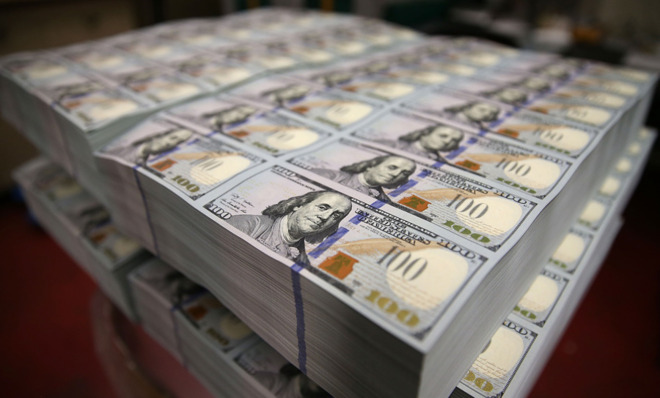How much is too much government spending?
Protip: Let the market be your guide

The majority of Americans think the U.S. government is spending too much and needs to curb its allegedly profligate ways. A full 63 percent of respondents surveyed by Pew in January believed that deficit reduction should be a top priority, although that was down from 72 percent in January 2013, which is unsurprising given that the deficit has been cut by half since President Obama took office in 2009.
Obviously, some people believe government should be restrained to very minimal functions, like border control, a court system, and national defense. Other people believe that government should do much more — regulate markets, provide for basic welfare, create jobs, invest in scientific research, land spacecraft on the moon, etc. There are probably as many different opinions on the size of government as there are people.
So let’s put aside ideological arguments, as well as political constraints like the debt limit, and try to pinpoint when government spending becomes too much.
The Week
Escape your echo chamber. Get the facts behind the news, plus analysis from multiple perspectives.

Sign up for The Week's Free Newsletters
From our morning news briefing to a weekly Good News Newsletter, get the best of The Week delivered directly to your inbox.
From our morning news briefing to a weekly Good News Newsletter, get the best of The Week delivered directly to your inbox.
It’s easy to assume that the government has to balance the budget. After all, for a business, household, or individual — or even governments using another’s currency, like those in the euro zone — debts must be serviced from income. In a 2013 poll, 85 percent of Americans supported a balanced budget amendment, which would prohibit the government from spending more than it takes in in tax revenues.
But for countries with their own currency, also known as monetary sovereigns, it’s not so simple. If you have a printing press that can produce literally as much money as you want, then you’re not constrained to only spending the amount that you can tax. And if you want to undertake large, expensive projects that may exceed your tax revenues — like winning World War II, landing a man on the moon, building an interstate highway system, or creating a national fiber optic broadband network — then the money can easily be found.
Some will say that printing money is inflationary, which risks damaging confidence in the currency. To a certain extent, this is true. If the market loses confidence in the currency completely, then the market value can fall, and in extreme cases go to zero.
One way to ensure confidence in the monetary system is to have an independent central bank, and to make the government go to the market to borrow money. This is the situation in the United States today, and it is the ultimate check on government spending.
A free daily email with the biggest news stories of the day – and the best features from TheWeek.com
Government competes for lenders’ money in the marketplace. If the rate of inflation is rising, or if lenders are worried about fiscal sustainability or the government crowding out private enterprise, then they are free to demand higher rates of interest. On the other hand, if you have lots of slack capacity — unemployed people looking for jobs, idle factory capacity, businesses and individuals sitting on large piles of uninvested cash, which is precisely what has occurred since 2008 — then credit will be cheap, as demand for credit will be low.
This creates an important measure of how much it is possible for the government to spend at any given time. Today, inflation remains below the Federal Reserve’s 2 percent target, and interest rates on government borrowing also remain near all-time lows. So in spite of the fact that the government is taking in considerably less than it spends, the market is unconcerned about the sustainability of that spending. This means that in spite of the higher deficits, the costs of servicing the U.S. debt today are low by historical standards at just 6 percent of federal spending, way down from 15 percent in the 1990s.
What does that mean? The federal government isn’t anywhere near spending beyond its natural limits, and can easily increase spending to invest in infrastructure projects and lower unemployment. Aiming to make up the output gap, for example, is a realistic goal.
John Aziz is the economics and business correspondent at TheWeek.com. He is also an associate editor at Pieria.co.uk. Previously his work has appeared on Business Insider, Zero Hedge, and Noahpinion.
-
 Animal Farm: has Andy Serkis made a pig’s ear of Orwell?
Animal Farm: has Andy Serkis made a pig’s ear of Orwell?Talking Point Animated adaptation of classic dystopian novella is light on political allegory and heavy on lowbrow gags
-
 What new cryptocurrency regulations mean for investors
What new cryptocurrency regulations mean for investorsThe Explainer The Treasury and the Financial Conduct Authority aim to make the UK a more attractive and safer place for crypto assets
-
 The Salt Path Scandal: an ‘excellent’ documentary
The Salt Path Scandal: an ‘excellent’ documentaryThe Week Recommends Sky film dives back into the literary controversy and reveals a ‘wealth of new details’